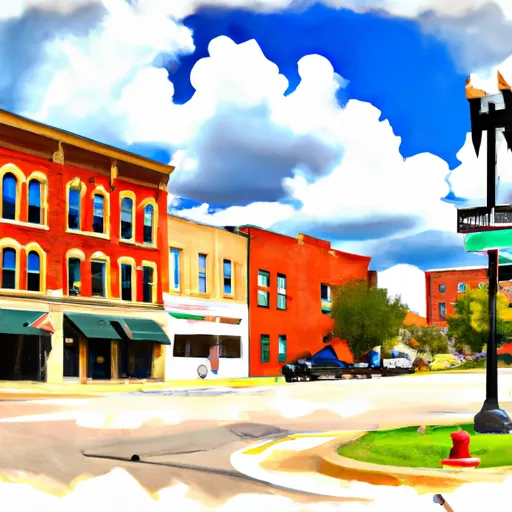-
 Snoflo Premium
Snoflo Premium
Get unlimited access to all our content
With no Ad interruptions! - Start Your Free Trial Login with existing account
Mansfield
Eden Index
Climate
9.5
•
Recreation
3.1
•
Community
1.1
•
Safeguard
5.2/10

Mansfield, Illinois is a small village located in Piatt County, in the central part of the state. The climate of Mansfield is classified as a humid continental climate, characterized by hot, humid summers and cold winters. Summers average around 85°F (29°C), while winters can drop to 20°F (-6°C). Precipitation is evenly distributed throughout the year, with an annual average of 39 inches (99 cm).
Hydrologically, Mansfield is situated in the Upper Sangamon River watershed. The Sangamon River, running nearby, is the main water source for the region. The river provides opportunities for fishing, canoeing, and boating.
Outdoor recreation opportunities in Mansfield and its surroundings include several parks and natural areas. Mansfield Village Park offers green space, picnic areas, and playgrounds for families to enjoy. Nearby, the Clinton Lake State Recreation Area provides opportunities for camping, hiking, hunting, and fishing. The park also features a marina for boating enthusiasts. For nature lovers, the Allerton Park and Retreat Center is a stunning 1,500-acre estate with walking trails, formal gardens, and historical architecture.
In summary, Mansfield, Illinois, offers a pleasant climate, abundant water resources, and diverse outdoor recreation opportunities for residents and visitors to enjoy throughout the year.
What is the Eden Index?
The Snoflo Eden Index serves as a comprehensive rating system for regions, evaluating their desirability through a holistic assessment of climate health, outdoor recreation opportunities, and natural disaster risk, acknowledging the profound impact of these factors on livability and well-being.
Climate Health Indicator (CHI): 9.5
Mansfield receives approximately
955mm of rain per year,
with humidity levels near 79%
and air temperatures averaging around
11°C.
Mansfield has a plant hardyness factor of
5, meaning
plants and agriculture in this region thrive during a short period during spring and early summer. Most
plants will die off during the colder winter months.
By considering the ideal temperature range, reliable water supplies, clean air, and stable seasonal rain or snowpacks, the Climate Health Indicator (CHI) underscores the significance of a healthy climate as the foundation for quality living.
A healthy climate is paramount for ensuring a high quality of life and livability in a region, fostering both physical well-being and environmental harmony. This can be characterized by ideal temperatures, reliable access to water supplies, clean air, and consistent seasonal rain or snowpacks.
Weather Forecast
Streamflow Conditions
Lower Illinois
Area Rivers
Lower Illinois
Snowpack Depths
Lower Illinois
Reservoir Storage Capacity
Lower Illinois
Groundwater Levels
Recreational Opportunity Index (ROI): 3.1
The Recreational Opportunity Index (ROI) recognizes the value of outdoor recreational options, such as parks, hiking trails, camping sites, and fishing spots, while acknowledging that climate plays a pivotal role in ensuring the comfort and consistency of these experiences.
Access to outdoor recreational opportunities, encompassing activities such as parks, hiking, camping, and fishing, is crucial for overall well-being, and the climate plays a pivotal role in enabling and enhancing these experiences, ensuring that individuals can engage in nature-based activities comfortably and consistently.
Camping Areas
| Campground | Campsites | Reservations | Toilets | Showers | Elevation |
|---|---|---|---|---|---|
| Clarkco State Park | None | 273 ft | |||
| Livingston County 4-H Park | None | 636 ft | |||
| Moraine View State Park | 200 | 853 ft | |||
| Archusa Creek Waterpark | 69 | 315 ft | |||
| Lake Tom Bailey | 32 | 299 ft | |||
| Jurgens City Park | None | 658 ft | |||
| South City (Gibson) Park | None | 741 ft | |||
| Gibson City Park | 4 | 731 ft | |||
| Sam Dale Lake Conservation Area | None | 493 ft | |||
| Charley Brown City Park | None | 487 ft |
Nearby Ski Areas
Catastrophe Safeguard Index (CSI):
The Catastrophe Safeguard Index (CSI) recognizes that natural disaster risk, encompassing floods, fires, hurricanes, and tornadoes, can drastically affect safety and the overall appeal of an area.
The level of natural disaster risk in a region significantly affects safety and the overall livability, with climate change amplifying these risks by potentially increasing the frequency and intensity of events like floods, fires, hurricanes, and tornadoes, thereby posing substantial challenges to community resilience and well-being.
Community Resilience Indicator (CRI): 1.1
The Community Resilience Indicator (CRI) recognizes that education, healthcare, and socioeconomics are crucial to the well-being of a region. The CRI acknowledges the profound impact of these elements on residents' overall quality of life. By evaluating educational resources, healthcare accessibility, and economic inclusivity, the index captures the essential aspects that contribute to a thriving community, fostering resident satisfaction, equity, and social cohesion.

